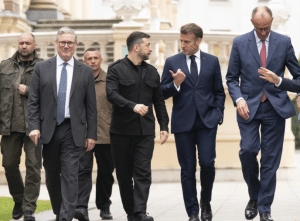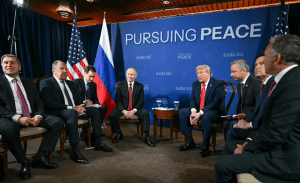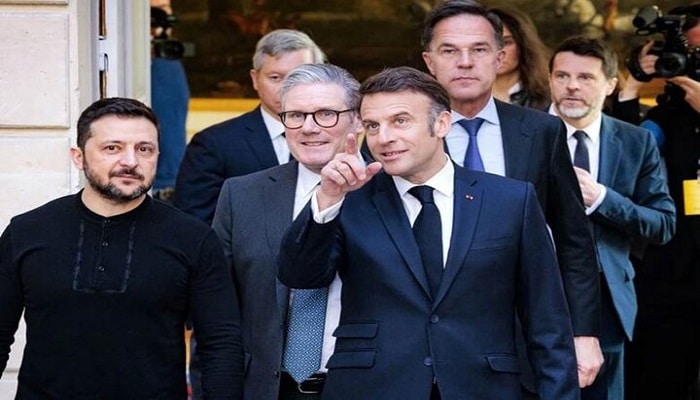PNN – Three days after the Alaska meeting, Zelensky arrived in Washington today; what is the purpose and message of this trip, and is Trump reconsidering relations with Russia?
Just a few days after the controversial meeting between Donald Trump and Vladimir Putin in Alaska, which ended with a vague statement and no definitive outcome regarding a ceasefire or political agreement, all eyes are once again on Washington.
This time, the Western diplomatic scene will be shaped by the simultaneous presence of several key players; Ukrainian President Volodymyr Zelensky, along with the leaders of the European Troika (Germany, France, and the United Kingdom), along with the President of the European Commission and the Secretary General of NATO, will meet with Trump at the White House today, Monday, August 18.
The significance of this trip lies not only in the high level of engagement of the European leaders but also in its critical timing, right after the inconclusive Trump-Putin talks that have raised concerns about the possibility of a “fragile peace” or even a backroom deal over Ukrainian territory. The presence of European leaders on this trip sends a clear and unambiguous message.
Travel message and agenda of the European delegation
Zelensky’s visit to Washington today, accompanied by German Chancellor Friedrich Mertz, French President Emmanuel Macron, British Prime Minister Keir Starmer, and NATO Secretary General Mark Rutte, carries a clear message: a message that Europe and NATO do not want the fate of the Ukrainian war to be determined in their absence and solely in the context of bilateral Trump-Putin talks.

European leaders, appearing at the White House alongside the Ukrainian president, are trying to remind Trump that any peace agreement or ceasefire framework will lack legitimacy without the vote and consent of Kiev and without joint transatlantic support.
In addition to supporting Ukraine and demanding security guarantees for the country, creating a united European front is another message of this trip; a message that French President Emmanuel Macron directly referred to and emphasized yesterday, Sunday, after a video conference meeting with the heads of states allied with Kiev: Monday’s meeting between US President Donald Trump and Ukrainian President Volodymyr Zelensky aims to create a united European front.
It seems that the agenda of this European and NATO delegation is based on several key axes, including:
– Attempting to present a political package similar to NATO’s “Article 5” that would guarantee a collective response commitment, even though Ukraine is not an official member of the treaty.
– Emphasis on the territorial red line; no part of Ukrainian territory can be traded as the price of peace.
– Establishing sustainable financial and military aid to Ukraine and linking it to any possible diplomatic process.
– Prevent Moscow from interpreting the Alaska meeting as a green light for more pressure on the war fronts.
This composition and agenda show that today’s trip, more than just a formal meeting, has become a stage to demonstrate Western unity and contain possible American unilateralism.
Risks and challenges facing the Troika and Ukraine
Although the simultaneous presence of Zelensky, European leaders, and the NATO Secretary General in Washington is a clear demonstration of Western solidarity, this trip is inherently accompanied by a set of risks and challenges that could affect its outcome and final message.

The first challenge is the ambiguity of security guarantees. Although the plan, which has been proposed as a “pseudo-Article 5 of NATO,” could serve as a political shield for Ukraine, the main question is what mechanism for a rapid and collective response will be defined in practice. The lack of a clear mechanism risks creating an ambiguous and ineffective deterrent.
The second challenge is Russia’s territorial pressures. Moscow has repeatedly stated that it will not compromise without recognizing its control over regions such as Donetsk and Luhansk. Europe wants to ensure that no talks on territorial concessions are on the agenda, but Russian pressure and Trump’s temptation to reach a quick agreement could threaten this red line.
The third risk is domestic consequences in the US and Europe. Trump faces domestic criticism in Washington over his foreign policy and the costs of the Ukraine war, and any agreement could become a tool for electoral competition. In Europe, leaders are also facing pressure from public opinion and opposition parties to reduce war costs, and this is affecting the flexibility of their positions.
The fourth challenge is the high expectations of the trip. The simultaneous presence of so many high-level leaders has raised public expectations for a tangible outcome. If today’s meeting results in nothing more than a vague statement, it will not only dilute the message of Western unity but may also play into the Russian narrative of Western inefficiency in collective decision-making.
Prospects for the meeting and feasibility of changing Trump’s approach
Today’s Washington meeting, attended by Zelensky and European leaders, is seen by observers as a strategic attempt to pressure Trump and limit his room for maneuver after the Alaska meeting. Although the first meeting between Trump and Putin was accompanied by a positive atmosphere and expressions of satisfaction on both sides, and the US President spoke of “great progress”, the lack of agreement gave hope to Europe to try its luck with a joint trip to Washington.
Of course, this is one side of the coin, and such an ambiguous atmosphere could pave the way for secret bilateral agreements between Putin and Trump, agreements that would likely focus on Ukrainian territory.
It should be noted that Trump’s political personality and his desire for a quick agreement remain the biggest obstacle to changing his fundamental approach. The experience of the Alaska negotiations showed that Trump, regardless of European sensitivities, is interested in presenting himself as an “architect of peace” – even if the price is concessions to Moscow. Therefore, it seems unlikely that he will completely sideline Putin or stop the path of bilateral talks at this stage.

The presence of European leaders in Washington could somewhat adjust Trump’s calculations. The meeting is likely to force him to adopt positions more in line with European allies, at least in public statements, and to emphasize the principle of “making decisions with Kiev.” Joint pressure from NATO and the European Union could also cause Trump to distance himself from overly hasty plans for a ceasefire or territorial concessions.
Trump is unlikely to fundamentally change his approach. He is looking for an agreement that he can present at home as a personal achievement and a symbol of his negotiating ability. To that end, his desire to maintain a close relationship with Putin is crucial. Therefore, the more likely outcome of today’s meeting is for Trump to adopt a dual stance: on the surface, aligning himself with Europe and Ukraine, and behind the scenes, continuing the path of dialogue with Russia.
In other words, the Washington meeting could influence the tone and appearance of Trump’s policy, but it is unlikely to fundamentally change the nature of his approach to Moscow. The future of relations and the war in Ukraine will remain dependent on the subsequent trade-offs between Trump and Putin.

